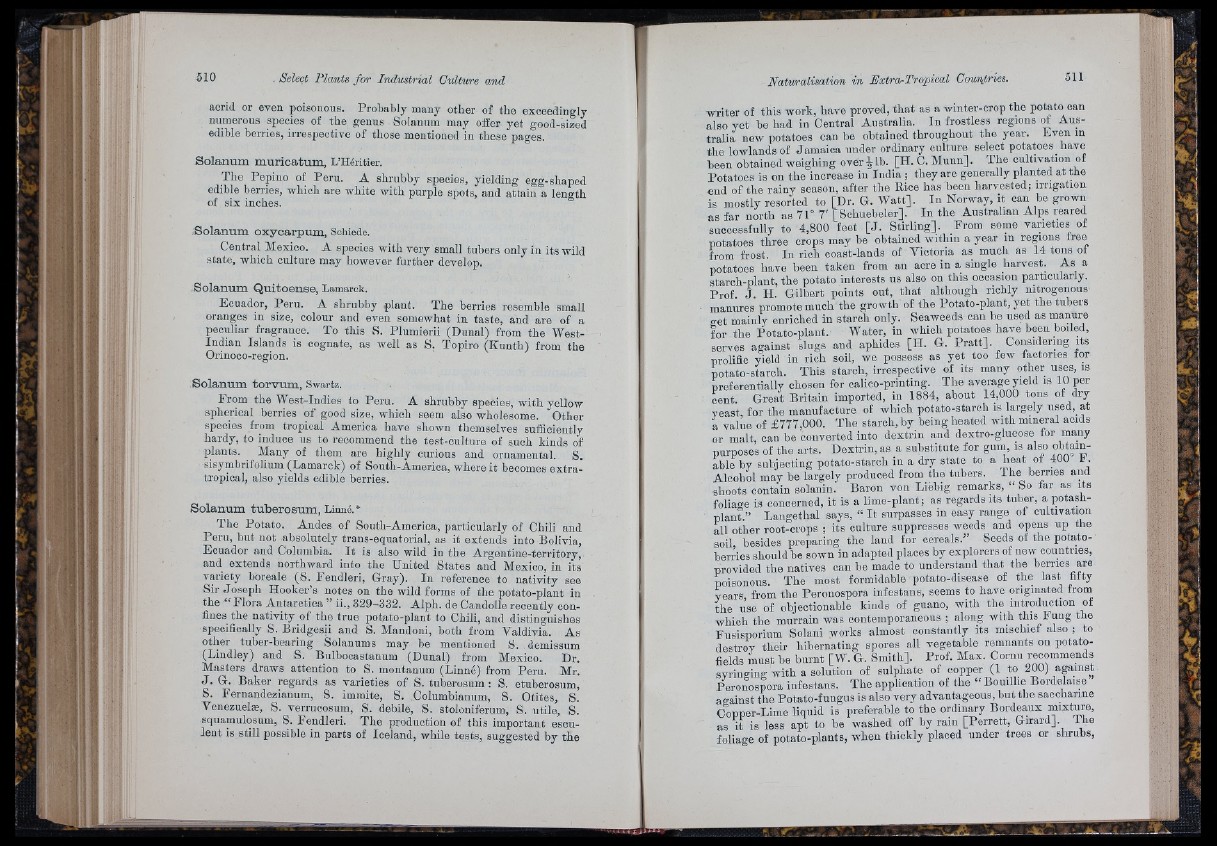
Ni J U
l / ï
'!■ i
’H 1:1
:iU
; :
■ ?
acrid or even poisonous. Probably many other of the exceedingly
numerous species of the genus Solanum may offer yet good-sized
edible berries, irrespective of those mentioned in these pages.
S o l a n u m m u r io a tu m , L’Héritier.
The Pepino of Peru. A shrubby species, yielding egg-shaped
edible berries, which are white with purple spots, and attain a length
of six inches.
Solanum oxyoarpum, Schiede.
Central Mexico. A species with very small tubers only in its wild
state, which cnlture may however further develop.
Solanum Quitoense, Lamarck.
Ecuador, Peru. A shrubby plant. The berries resemble small
oranges iu size, colour and even somewhat in taste, and are of a
peculiar fragrance. To this S. Plumierii (Dunal) from the West-
Indian Islands is cognate, as well as S, Topiro (Kunth) from the
Orinooo-region.
Solanum torvum, Swartz.
From the West-Indies to Peru. A shrubby species, with yellow
spherical berries of good size, which seem also wholesome. Other
species from tropical America have shown themselves sufficiently
liardy, to induce us to recommend the test-culture of such kinds of
plants. ^ Many of them are highly curious and ornamental. S.
sisymbrifoliiim (Lamarck) of South-America, where it becomes extra-
tropical, also yields ediblo berries.
Solanum tuberosum, Linné.*
The Potato. Andes of South-America, particularly of Chili and
Peru, but not absolutely trans-equatorial, as it extends into Bolivia,
Ecuador and Columbia. I t is also wild in the Argentine-territory,
and extends northward into the United States and Mexico, in its
variety boreale (S. Eendieri, Gray). In reference to nativity see
Sir Joseph Hooker’s notes on the wild forms of the potato-plant in
the ■“ Flora Antarctica ” ii., 329-332. Alph. de Caudolie recently confines
the nativity of the true potato-plant to Chili, and distinguishes
specifically S. Bridgesii and S. Mandoni, both from Valdivia, As
other tuber-bearing Solanums may be mentioned S. demissum
(Lindley) and S. Bulbooastanum (Dunal) from Mexico. Dr.
Masters draws attention to S. montanum (Linné) from Peru. Mr.
J . G. Baker regards as varieties of S. tuberosum : S. etuberosum,
S. Fernandezianum, S. immite, S. Columbianiim, S. Otites, S.
Veuezuelae, S. verrucosum, S. debile, S. stoloniferum, S. utile, S.
sqiiamulosum, S. Fendleri. The production of this important esculent
is still possible in parts of Iceland, while tests, suggested by the
writer of this work, have proved, th a t as a winter-crop the potato can
also yet be had in Central Australia. In frostless regions ot Australia
new potatoes can be obtained throughout the year. Even in
the lowlands of Jamaica under ordinary culture select potatoes have
been obtained weighing over 4 lb. [H. C. Mu n n ]. The cnltivation of
Potatoes is on the increase in India ; they are generally planted at the
end of the rainy season, after the Rice has been harvested; irrigation
is mostly resorted to [Dr. G. W a tt]. In Norway, it can be grown
as far north as 71° 7' [Schuebeler]. In the Australian Alps reared
successfully to 4,800 feet [ J . Stirling]. From some varieties of
potatoes three crops may he obtained within a year m regions free
from frost. In rich coast-lands of Victoria as much as 14 tons oi
potatoes have been taken from an acre in a single harvest. As a
starch-plant, the potato interests us also on this occasion particularly.
P ro f J H. Gilbert points out, th a t although richly nitrogenous
manures promote much the growth of the Potato-plant, yet the tubers
get mainly enriched iu starch only. Seaweeds can be used as manure
for the Potato-plant. Water, in which potatoes have been boiled,
serves against slugs and aphides [H. G. P ra tt]. Considermg its
prolific yield in rich soil, we possess as yet too few factories for
potato-starch. This starch, irrespective of its many other uses, is
preferentially chosen for calico-printing. The average yield is 10 per
cent. Great Britain imported, in 1884, about 14,000 tons of dry
yeast for the manufacture of which potato-starch is largely used, at
a v a lle of £777,000. The starch, by being heated with mineral acids
or malt, can be converted into dextrin and dextro-gluoose for many
purposes of the arts. Dextrin, as a substitute for gum, is also ohUm-
able by subjecting potato-starch in a dry state to a heat ot 400 b .
Alcohol may be largely produced from the tubers. The berries and
shoots contain solanin. Baron von Liebig remarks, “ bo tar as its
foliage is concerned, it is a lime-plant; as regards its tuber, a potash-
plant.” Langethal says, “ I t surpasses in easy range of cultivation
all other root-ciops ; its culture suppresses weeds and opens up the
soil besides preparing the land for cereals.” Seeds of the potato-
herries should be sown in adapted places by explorers of new countries,
provided the natives can he made to understand that the berries are
poisonous. The most formidable potato-disease of the last fatty
years, from the Peronospora infestans, seems to have originated from
the use of objectionable kinds of guano, with the introduction
which the murrain was contemporaneous ; along with this Fung the
Fusisporium Solani works almost constantly its mischief also ; to
destroy their hibernating spores all vegetable remnants on potato-
fields must be burnt [W. G. Smith]. Prof. Max. Cornu recommends
syringing with a solution of sulphate of copper (1 to 200) against
Peronospora infestans. The application of the “ Bouillie Bordelaise
ao-ainst the Potato-fungus is also very advantageous, but tlie saccharine
C'opper-Lime liquid is preferable to the ordinary Bordeaux mixture,
as it is less apt to be washed off by ram [Perrett, Girard]. The
foliage of potato-plants, when thickly placed under trees or shrubs,